|
G3VGR
|
ALTMÜHLTAL PANORAMAWEG Dollnstein – Eichstätt
|
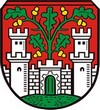 Having completed the first two stages, it was now time to move on from my Treuchtlingen base.
With a full backpack, I caught the train back to Dollnstein for the 16Km walk to the baroque town of Eichstätt.
It had been raining overnight and the morning was cool and cloudy. My head cold was causing me much discomfort, but I was happy to be back in Dollnstein and looking forward to visiting Eichstätt.
Leaving Dollnstein through the historic Petersturm, I walked along a forest path and across the Mühlbergleite, another juniper heath and followed the Altmühl until reaching the imposing Burgsteinfelsen.
This impressive 45 metre high geotope is very popular with rock climbers, having 30 climbing routes of various difficulty levels.
Unfortunately, the Panoramaweg leads one behind the Burgensteinfelsen, denying the views seen in the promotional literature. I was amazed by the stupidiy of this routing, so decided to make amends by backtracking down the trail a little, then bushwhacking down a steep track to the Radweg.
The steep descent was going well until reaching a bare patch under some trees. Due to the previous rain, the mud crumbled and I slipped and slid down on my back for about 5 metres. My shorts, pack, legs and one arm were covered in mud.
On reaching the bottom, I cleaned myself up as best as possible in a roadside puddle. I was also getting some strange looks from passing cyclists as I stood in my underpants after removing my shorts to clean the worst of the mud from them.
At least I could now view and admire the Burgsteinfelsen. Continuing along the cycle track, I rejoined the Panoramaweg just past Breitenfurt.
It started to rain quite heavily and I trudged along the slopes of the Schernfelder Leite, another Wacholderheide, towards the village of Obereichstätt.
Having completed the first two stages, it was now time to move on from my Treuchtlingen base.
With a full backpack, I caught the train back to Dollnstein for the 16Km walk to the baroque town of Eichstätt.
It had been raining overnight and the morning was cool and cloudy. My head cold was causing me much discomfort, but I was happy to be back in Dollnstein and looking forward to visiting Eichstätt.
Leaving Dollnstein through the historic Petersturm, I walked along a forest path and across the Mühlbergleite, another juniper heath and followed the Altmühl until reaching the imposing Burgsteinfelsen.
This impressive 45 metre high geotope is very popular with rock climbers, having 30 climbing routes of various difficulty levels.
Unfortunately, the Panoramaweg leads one behind the Burgensteinfelsen, denying the views seen in the promotional literature. I was amazed by the stupidiy of this routing, so decided to make amends by backtracking down the trail a little, then bushwhacking down a steep track to the Radweg.
The steep descent was going well until reaching a bare patch under some trees. Due to the previous rain, the mud crumbled and I slipped and slid down on my back for about 5 metres. My shorts, pack, legs and one arm were covered in mud.
On reaching the bottom, I cleaned myself up as best as possible in a roadside puddle. I was also getting some strange looks from passing cyclists as I stood in my underpants after removing my shorts to clean the worst of the mud from them.
At least I could now view and admire the Burgsteinfelsen. Continuing along the cycle track, I rejoined the Panoramaweg just past Breitenfurt.
It started to rain quite heavily and I trudged along the slopes of the Schernfelder Leite, another Wacholderheide, towards the village of Obereichstätt.
At Obereichstätt, a brutal climb over the Obereichst�tter Steppenheide took me to the longest wooden bench in Germany (36.5 meters) on a plateau near Blumenberg, where I collapsed exhausted from the climb.
The rain stopped and I was recompensed with spectacular views of the valley.
Now, I was in another limestone quarry area and made a detour from the trail to visit the Museum Bergér but it didn't open until 1:30PM.
I passed the Fossiliensteinbruch Blumenberg, a fossil stone quarry where amateur palaeontologists can search for their own fossils hidden in the limestone pieces.
The quarry also rents hammers and chisels for visitors. Due to the school holidays, quite a few young people were trying their luck at finding fossils.
By now, the sky had cleared and I was enjoying a warm, sunny afternoon, although my severe cold didn't help me fully appreciate the nice weather.
From the quarry, the trail led me through the hamlet of Blumenberg, where I had a good view of the impressive Willibaldsburg, a fortified castle sat on a hilltop overlooking Eichstätt.
A long descent into the Tiefen Tal brought me to the outskirts of town.
Instead of heading directly into the centre of Eichstätt, the trail zigzags steeply back up the Geißberg to the "Neuer Weg" path, where a fairly level walk along a 270° perimeter above Eichstätt, provides views over the town.
However, I noticed a bus stop just across the road and not feeling too well from my heavy cold, I decided to give this section (which seemed superfluous) a miss and caught a bus into the Altstadt instead.
Close to the Altstadt is the Braugasthof Trompete, a popular stopover for hikers and my lodging for the night.
After a quick shower, I went off in the late afternoon sunshine to explore the town.
Eichstätt is quite an old town and can trace its origins back to Roman times.
It was destroyed during the Thirty Years War by the Swedes, who considered Eichstätt to be a bastion of Catholicism.
Eichstätt's baroque appearance is a result of the subsequent rebuilding in the 17th and 18th centuries under the influence of Italian architects.
With cobbled streets, elegant buildings and leafy piazzas, the Altstadt certainly has a Mediterranean-style elegance.
I was immediately impressed by the town, one of the most alluring I have visited.
The Residenzplatz is particularly beautiful with stately baroque buildings which ring the square.
At the Marktplatz, sitting outside a café with a coffee and cake in the late afternoon sun was a pleasant experience and the day's earlier rain, wind and slide through the mud was soon forgotten.
I also took the opportunity to visit the Eichstätter Dom, where a 8th century church originally stood, prior to being destroyed by an invasion of the Magyars.
Later in the evening, I visited the zum Gutmann Wirtshaus for a dinner of Altmühler Lamm.
The lamb is sourced locally from Schäferei Eichhorn and had a delicious flavour.
The Hefeweizen from Brauerei Gutmann, who own the inn, was excellent too.
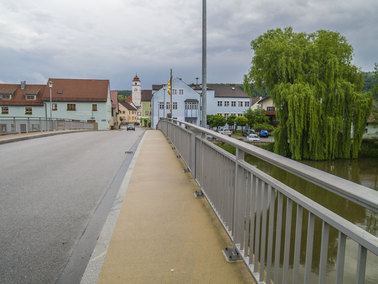
Making my way to Dollnstein Altstadt
|
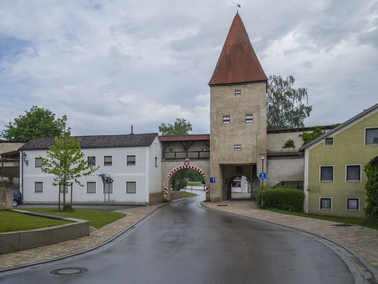
Dollnstein - Petersturm
|
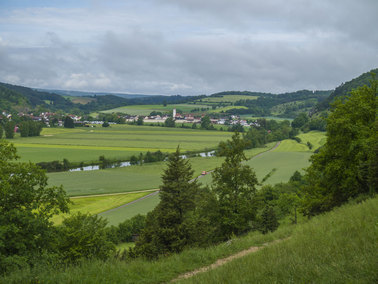
View back to Dollnstein
|
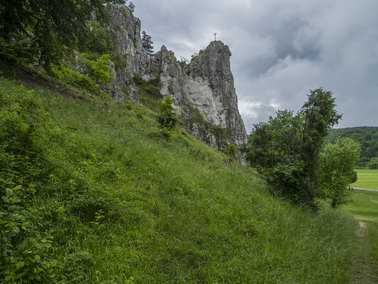
Panoramaweg disappearing behind Burgsteinfelsen
|
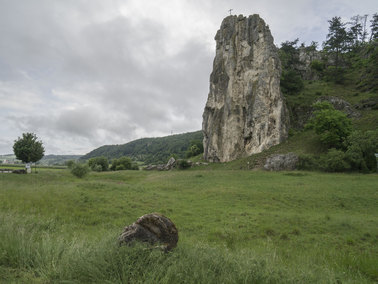
The impressive Burgsteinfelsen
|
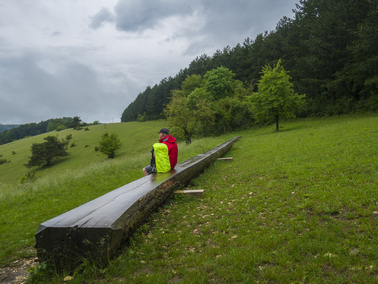
Sitting on Germany's longest wooden bench
|

The view over Obereichstätt and the Altmühltal
|

A working limestone quarry on the Blumenberg
|
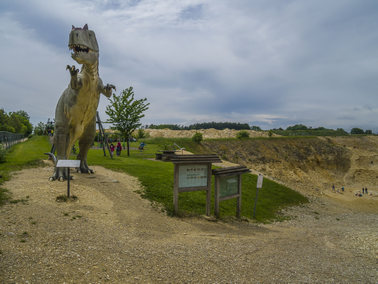
Fossiliensteinbruch Blumenberg
|
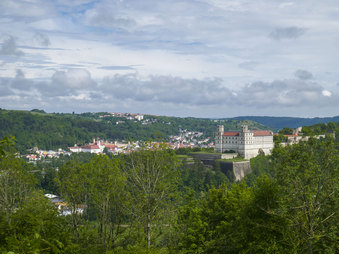
Willibaldsburg and Eichstätt
|

Eichstätt - Rudolfsplatz
|
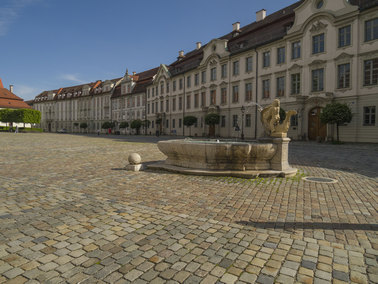
Eichstätt - Residenzplatz
|
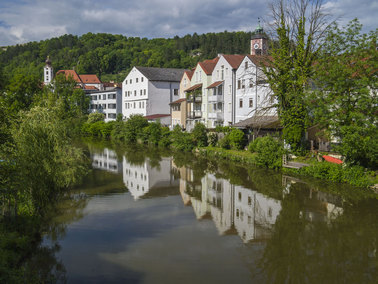
The Altmühl at Eichstätt
|

Eichstätt - Marktplatz
|
[Home]
 Having completed the first two stages, it was now time to move on from my Treuchtlingen base.
With a full backpack, I caught the train back to Dollnstein for the 16Km walk to the baroque town of Eichstätt.
It had been raining overnight and the morning was cool and cloudy. My head cold was causing me much discomfort, but I was happy to be back in Dollnstein and looking forward to visiting Eichstätt.
Leaving Dollnstein through the historic Petersturm, I walked along a forest path and across the Mühlbergleite, another juniper heath and followed the Altmühl until reaching the imposing Burgsteinfelsen.
This impressive 45 metre high geotope is very popular with rock climbers, having 30 climbing routes of various difficulty levels.
Unfortunately, the Panoramaweg leads one behind the Burgensteinfelsen, denying the views seen in the promotional literature. I was amazed by the stupidiy of this routing, so decided to make amends by backtracking down the trail a little, then bushwhacking down a steep track to the Radweg.
The steep descent was going well until reaching a bare patch under some trees. Due to the previous rain, the mud crumbled and I slipped and slid down on my back for about 5 metres. My shorts, pack, legs and one arm were covered in mud.
On reaching the bottom, I cleaned myself up as best as possible in a roadside puddle. I was also getting some strange looks from passing cyclists as I stood in my underpants after removing my shorts to clean the worst of the mud from them.
At least I could now view and admire the Burgsteinfelsen. Continuing along the cycle track, I rejoined the Panoramaweg just past Breitenfurt.
It started to rain quite heavily and I trudged along the slopes of the Schernfelder Leite, another Wacholderheide, towards the village of Obereichstätt.
Having completed the first two stages, it was now time to move on from my Treuchtlingen base.
With a full backpack, I caught the train back to Dollnstein for the 16Km walk to the baroque town of Eichstätt.
It had been raining overnight and the morning was cool and cloudy. My head cold was causing me much discomfort, but I was happy to be back in Dollnstein and looking forward to visiting Eichstätt.
Leaving Dollnstein through the historic Petersturm, I walked along a forest path and across the Mühlbergleite, another juniper heath and followed the Altmühl until reaching the imposing Burgsteinfelsen.
This impressive 45 metre high geotope is very popular with rock climbers, having 30 climbing routes of various difficulty levels.
Unfortunately, the Panoramaweg leads one behind the Burgensteinfelsen, denying the views seen in the promotional literature. I was amazed by the stupidiy of this routing, so decided to make amends by backtracking down the trail a little, then bushwhacking down a steep track to the Radweg.
The steep descent was going well until reaching a bare patch under some trees. Due to the previous rain, the mud crumbled and I slipped and slid down on my back for about 5 metres. My shorts, pack, legs and one arm were covered in mud.
On reaching the bottom, I cleaned myself up as best as possible in a roadside puddle. I was also getting some strange looks from passing cyclists as I stood in my underpants after removing my shorts to clean the worst of the mud from them.
At least I could now view and admire the Burgsteinfelsen. Continuing along the cycle track, I rejoined the Panoramaweg just past Breitenfurt.
It started to rain quite heavily and I trudged along the slopes of the Schernfelder Leite, another Wacholderheide, towards the village of Obereichstätt.

